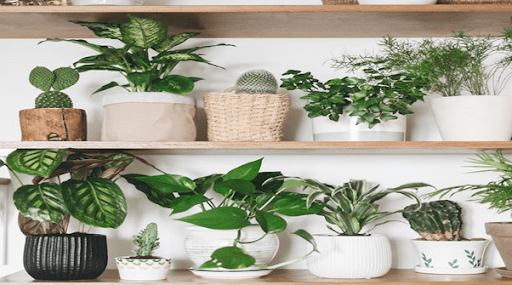When you grow a plant indoors for decorative purposes, they are called House Plants. House Plants have become a part of interior design these days in residences or offices. Owing to its calming and beautifying effect, these plants are in great demand. Studies have shown that plants also create positive vibes.
Indoor plants are known for their air purification property as their microbes absorb volatile organic compounds that are generally toxic to human beings. Being easy to take care of and requiring less space for indoor plants has proven to be the best option for those who love having plants around.
Some of the familiar houseplants are tropical or semi tropical epiphytes, succulent varieties of cacti. These plants require proper moisture, light levels, soil mixture, temperature, and humidity for survival. Fertilisers and suitable container sizes for growing them also play a great role in having a healthy plant.
What is a plant cell?
The structural and functional unit of the plant is called a cell. A plant cell has a cell wall, membrane-bound nucleus and a few other cell organelles. Each organelle carries out a specific function.
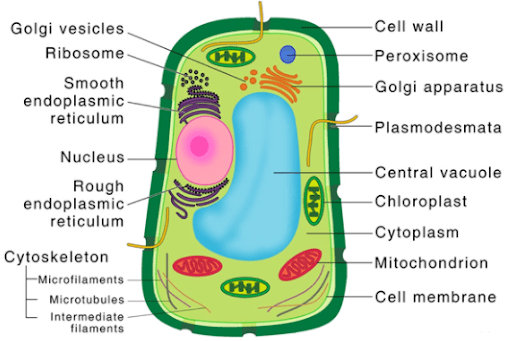 What are tissues and tissue systems?
What are tissues and tissue systems?
When structurally and functionally similar cells organise, they form tissue. Tissue system refers to a group of functionally similar but structurally dissimilar cells or tissues.
There are three tissue systems in plants:
1) Dermal tissue: Composed of epidermal cells. These cells are closely packed and secrete a waxy cuticle that prevents water loss.
2) Ground tissue: Composed of Parenchyma, collenchyma, and sclerenchyma cells.
3) Vascular tissue: It includes vascular tissue xylem, phloem, parenchyma, and cambium cells. These are involved in the transportation of food, water, hormones and minerals within the plant.
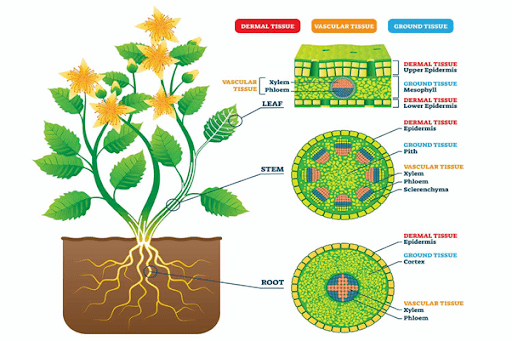 Plant tissue is generally classified into two types based on the type of cell it contains:
Plant tissue is generally classified into two types based on the type of cell it contains:
- Meristematic tissue
- Permanent (or non-meristematic) tissue
Let’s learn about these issues and identify the differences between Meristems Vs Permanent Tissues.
Meristematic tissues:
- This term was coined by Karl Nageli (the Greek word ‘merizen’ means to divide).
- Meristematic tissue (meristems) are formed of cells that are not differentiated or incompletely differentiated. They continue to divide and contribute to the plant’s growth, creating other tissues and organs of plants.
- Meristematic tissues are responsible for the increase in length and thickness of a plant.
- This tissue can be found in the tips of stems or roots where primary growth occurs.
- These cells are roughly spherical or polyhedral to rectangular, with thin cell walls.
- As the new cells grow and mature, their characteristics slowly change, and they become differentiated as components of meristematic tissue, namely apical, lateral and intercalary meristem.
Types of Meristematic tissues
- Apical meristem: Can be found at the growing tips of stems and roots. They increase the length of the root and stem. Meristems lead to the linear growth of an organ. These are responsible for primary growth in plants. It is further classified as shoot and root apical meristem.
- Lateral meristem: The cells that divide in one plane and increase in diameter and girth of an organ. It is seen beneath the tree’s bark as cork cambium and in vascular bundles of dicotyledons as vascular cambium. The activity of this cambium is responsible for secondary growth.
- Intercalary meristem: These are located at the node’s base, internode, and on leaf base between permanent tissues. Growth in length of the plant and increase in the size of the internode is caused by intercalary meristem leading to branch formation and growth.
 Characteristics of meristematic tissues
Characteristics of meristematic tissues
- Lateral, apical and intercalary cells are similar in structure
- Thin and elastic primary cell wall made of cellulose is present
- Closely arranged with no intercellular spaces between
- Cells consists of dense cytoplasm, and also a prominent cell nucleus is present
- The Protoplasm has fewer vacuoles.
- Cells shapes are oval, rectangular or polygonal
- Large nucleus with small or Vacuoles are absent
Permanent tissues:
- Living or dead plant cells formed by meristematic tissue that are no longer actively dividing and are at fixed positions in the plant body are called Permanent tissue.
- Meristematic tissues undergo cellular differentiation (the process of taking up a permanent shape, size and function) to take up a specific role and lose the ability to divide to form different permanent tissues.
Types of Permanent tissues
- Simple permanent tissue: Group of cells having similar origin, shape and function. They are of following types: Parenchyma, collenchyma and sclerenchyma, Aerenchyma, Epidermis, Chlorenchyma
- Parenchyma: Live unspecialised cells, loosely packed and have thin cell walls
- Collenchyma: Gives flexibility to plants. Found in leaf stalks. Living cells have irregular thickening and have fewer intercellular spaces.
- Sclerenchyma: Hardness in plants is due to these cells. E.g., Husk of coconut. They have lignin deposition and are dead cells. These cells have no internal space.
- Aerenchyma: These cells are found in aquatic plants. Due to the large air cavity, they make plants buoyant and help them to float. These are Parenchyma cells.
- Epidermis: It is the outermost layer of the cell. It protects plants from external conditions like water loss. No internal spaces are present in these cells. Stomata and guard cells in leaves occur in the epidermal layer.
- Chlorenchyma: Parenchyma cells containing chloroplasts and are involved in photosynthesis are called chlorenchyma.
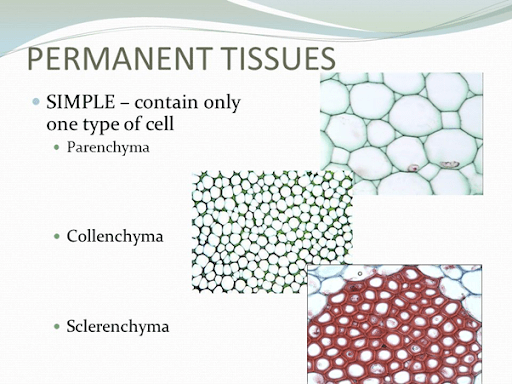 The difference between Parenchyma, collenchyma and sclerenchyma is in the below table:
The difference between Parenchyma, collenchyma and sclerenchyma is in the below table: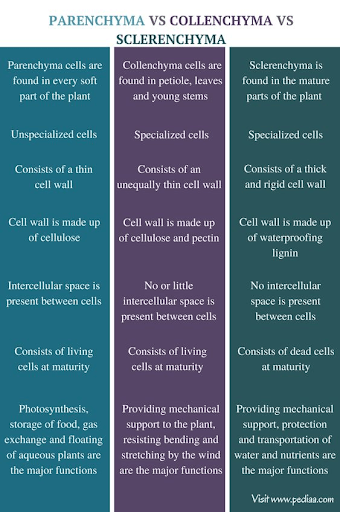
- Complex Permanent Tissue
The group of structurally different cells that coordinate to perform a common set of specialised functions in the plant body is called complex permanent tissue. They are two types: Xylem and Phloem.
- Xylem
- Transfers water and minerals to the leaves and stem from roots
- Supports plants
- It consists of tracheids, vessels, xylem fibres and xylem parenchyma
- Phloem
- Helps in food translocation to various parts from the location of photosynthesis (leaves)
- It consists of sieve tubes, phloem fibres, phloem parenchyma and companion cells.
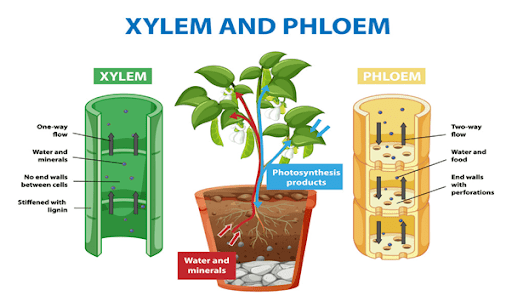 Differences between simple and complex permanent tissue are explained below:
Differences between simple and complex permanent tissue are explained below:
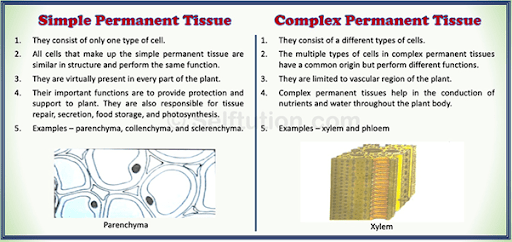 The below table illustrates the differences between meristem and permanent tissues
The below table illustrates the differences between meristem and permanent tissues
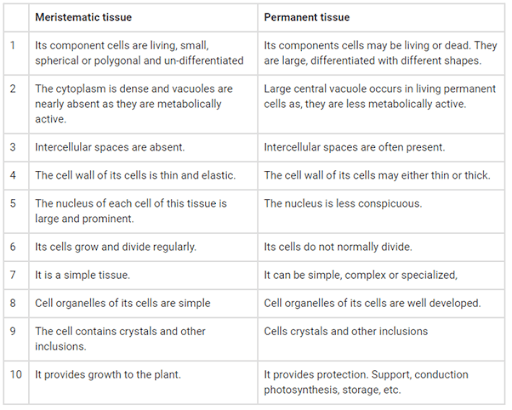 Conclusion
Conclusion
Now we know about plant, cell and tissue systems and how they divide and grow. It’s high time we realise that the Earth we inherited needs to be passed to our next generations cleaner and greener. House plants understand your busy concerns, and they can fill up your space with serenity and add life to your abode with little effort. Choose what suits your needs and enjoy the happiness they offer.

Talha Ali is your tech generalist, covering a wide spectrum of topics within the ever-evolving world of technology. With a curiosity for the latest innovations, industry trends, and breakthroughs. Whether it’s hardware, software, emerging technologies, or the intersection of tech with daily life, Talha’s articles provide readers with a well-rounded perspective on the dynamic landscape of the tech industry.

